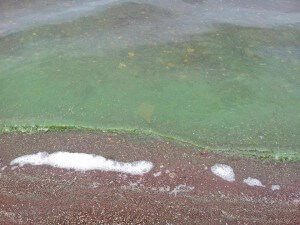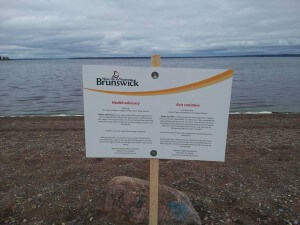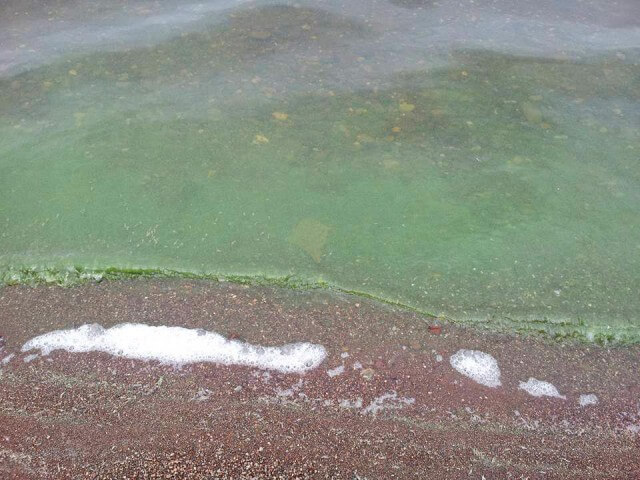When you hear about “blue-green algae blooms” you may conjure up images of Lake Erie or Lake Winnipeg which in 2013 won the dubious distinction of the World’s Most Threatened Lake. So full of blue-green algae, you can see the blooms from space. Yikes.
We’ve got a bit of our own blue-green algal bloom problem in New Brunswick. Not as big and widespread as Lake Winnipeg mind you, but this summer the tiny cells are pausing New Brunswickers from taking a dip in some of our most widely used recreational lakes in the province.
Just this week Washademoak Lake was added to the growing list of Lakes with a bit of a fever. Before that it was Grand Lake and Harvey Lake. A few others have been on the algae watch list for a few years now including Lake Utopia, Chamcook Lake, Lac Baker and Lac Unique.
What is Blue-Green Algae? Well, not an algae at all.

Blue-green algae is actually a photosynthetic cyanobacteria. Early scientists mistook it for algae. It is naturally occurring in waters and has been around for millions of years – one of the oldest forms of life. When the conditions are right, its individual microscopic cells collectively form a colourful blue-y, green-ish, brown-esque “bloom”. The bacteria blooms often form in water that is shallow, slow moving and warm – lakes in the summertime are often ripe with these conditions. Some experts also say that climate change (warming waters, heavier rainfalls) has also contributed to the bacteria’s growth.
While naturally occurring, a bloom can also be triggered by pollution into a water body, mostly phosphorous – a nutrient that is very common in our lives. Some of the common sources of phosphorous to our waters include:
- Septic systems: septic systems that store and treat sewage and household wastewater on individual rural and shoreline properties can leach phosphorus and other contaminants into nearby water bodies when not properly installed, maintained or monitored. Soaps and detergents down the drain are also a large source of phosphorus from households.
- Runoff: rain and snowmelt can carry a combination of phosphorus and other contaminants directly into our waterways and also our storm sewers systems. The phosphorus in runoff can come from lawn and garden fertilizers, agricultural lands, pet waste, and decomposing organic forest and yard waste.
- Atmospheric deposition: phosphorus can also make its way into water bodies from the air by wind, rain and snowfall from such activities as exposed landfill and compost heaps, coal combustion, and dust from quarries, agricultural fields and unpaved roads.
- Internal loading: when the soil and sediments of a lake are stirred up during dredging activities (the process of clearing or deepening navigational routes) or natural processes that cause the lake waters to mix from changes in temperatures or high winds, phosphorus can make its way back into the water column.
Why is an algal bloom concerning?
An algal bloom tends to mean that the healthy balance of water quality parameters are a bit out of whack. As a bloom dies and decomposes, it eats up a lot of oxygen which is a critical component of a healthy water body. This is called eutrophication. Low levels of oxygen can be especially harmful to fish which need cool, oxygenated waters to thrive.

While we don’t want to scare anyone, certain strains of cyanobacteria (blue-green algae) can contain toxins which are poisonous. The toxins are usually released when the cells of the bacteria break open or die, which can be caused by cooler weather, rainfall and windy conditions. The New Brunswick Department of Health has issued public health advisories for the seven lakes in NB currently experiencing blooms and indicates that contact with skin may cause irritation and result in hives, rashes, or skin blisters and if inhaled byway of recreational activities such as water skiing, boating, swimming etc. and can cause illness in people and animals.
What we can do
It’s August, the height of our summer, and the last thing we all want is to stay away from the water! While the seven lakes currently experiencing algal blooms will continued to be monitored by the Department of Health, there are a few things we can do at home or at the cottage to reduce the amount of nutrients getting into our waters and prevent blooms from happening in the future:
- What you put down the drain can end up in our waters. Switch to phosphorous-free cleaning products like dishwasher detergents.
- What you put on your lawn or garden can end up in our waters. Avoid over using fertilizers and only apply when necessary and try non-toxic alternatives when possible.
- Make sure your septic system is checked and cleaned every five years or so.
- Leave your shoreline natural and if necessary restore the shoreline with fast growing vegetation to prevent erosion and help absorb nutrients before they enter the water. Wetland areas are especially important in filtering out nutrients like phosphorus and other contaminants.
For more information on public health implications of a blue-green algal bloom visit the Department of Heath’s Q & A
This article appeared in the Wednesday, Aug. 12 edition of the New Brunswick Telegraph-Journal

